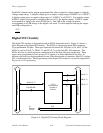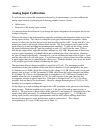
Chapter 4 Theory of Operation
© National Instruments Corporation 4-13 Lab-PC+ User Manual
Each 8253 contains three independent 16-bit counter/timers and one 8-bit Mode Register. As
shown in Figure 4-6, Counter Group A is reserved for data acquisition timing, and Counter
Group B is free for general use. The output of Counter B0 can be used in place of the 1 MHz
clock source on Counter A0 to allow clock periods greater than 65,536 µs. All six counter/timers
can be programmed to operate in several useful timing modes. The programming and operation
of the 8253 is presented in detail both in Appendix E, Register-Level Programming, and
Appendix B, OKI 82C53 Data Sheet.
The 8253 for Counter Group A uses either a 1 MHz clock generated from the onboard 10 MHz
oscillator or the output from Counter B0, which has a 2 MHz clock source, for its timebase.
Optionally, Counter B1 can be used to provide interval-scanning timing. In the interval-scanning
mode, the CLK pin of Counter B1 is driven by the same signal that is driving CLKA0. The
OUTB1 pin on the I/O connector initiates scan sequences that are separated by a programmable
scan interval time. The timebases for Counters B1 and B2 must be supplied externally through
the 50-pin I/O connector.
Figure 4-7 shows an example of interval-scanning timing.
OUTB1
OUTA0
GATEA0
ADC CH
CONVERT
CH1 CH0
CH1
CH0
Sample
Interval
Sample
Interval
Scan
Interval
Figure 4-7. Two-Channel Interval-Scanning Timing
The single-channel interval acquisition mode makes use of an additional 8-bit counter–the
Interval Counter. In this mode, Counter B1 initiates scan sequences that are separated by a
programmable interval time. The Interval Counter is programmed for the number of samples of
the selected channel in each interval. Figure 4-8 shows an example of single-channel interval
timing. In this example, Counter B1 is programmed for the sample interval and the Interval
Counter is programmed to count three samples, wait for the duration of the scan interval, count
three samples, and so on. The acquisition operation ends when the sample counter (Counter A1)
decrements to 0.


















